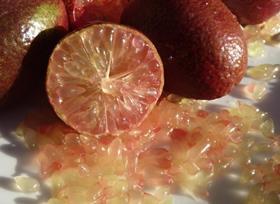
Unique, versatile and virtually exclusive. In red limes, Warren McIntosh has found a product that ticks every box when it comes to fresh produce marketability.
Described as a cross between an Australian finger lime and a Burmese Rangpur lime, McIntosh has been growing the fruit at his farm on the mid north coast of New South Wales for the past five years, with production spanning May through to August.
To his knowledge, he is one of only two commercial-scale growers of red limes in Australia, and potentially the world.
“They were developed by the CSIRO here in Australia and released years ago but they never really took off,” McIntosh tells Fruitnet . “When I heard about them I thought they’d complement my finger lime crop really well.
“I got onto the breeders and they told me no one was selling them commercially and I thought it was a good opportunity to bring something new and different to the market.”
Also marketed under the name blood limes in Australia and citron rouge in France, the fruit’s colour and juice-filled globules have made it popular among chefs looking for a distinctive garnish and bartenders looking to add colour, and some zest, to their cocktail creations.
The fruit has certainly found favour on Australia’s eastern seaboard, with McIntosh’s business, Gondwana Native Limes, oversubscribed with demand from sales agents in Sydney, Brisbane and Melbourne last season.
Several initial shipments to Europe also proved immensely popular with consumers in France, the Netherlands, Germany and Switzerland in 2017, with McIntosh now negotiating a contract with an agent in the UK to stock the fruit in one of Britain’s leading retailers.
McIntosh says there’s also been big interest from a hotel chain in Hong Kong, who met with one of Gondwana’s agents at Asia Fruit Logistica in September, while Japan will be on the radar once market access is granted.
“We’ll sell to anyone who wants the fruit and respects the fruit,” McIntosh says. “We’re one of the smallest orchards in the world but we also have one of the rarest crops and we want to deliver our fruit in the best possible condition from our farm to the end consumer.”






No comments yet